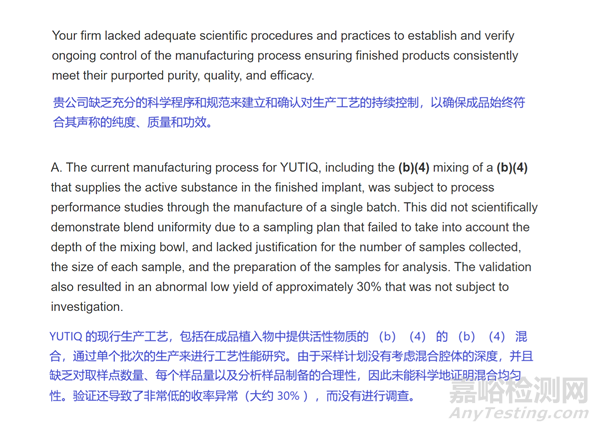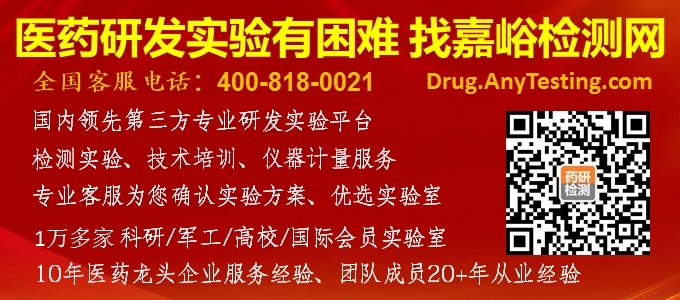您当前的位置:检测资讯 > 监管召回
嘉峪检测网 2024-10-08 20:53
With the introduction of the updated FDA guidance on process validation, a process validation life cycle was introduced in 2011. One of the stages in the cycle is the so-called Continued Process Verification stage 3, which shows whether the process remains permanently in a validated state. Many companies use statistical process control (SPC) to show the 'state of control' in this stage 3.
随着2011年新版 FDA 工艺验证指南的推出,引入了工艺验证生命周期概念。该周期的其中一个阶段即所谓的持续工艺确认-阶段 3,它提示工艺是否持续保持验证状态。许多公司使用统计过程控制 (SPC) 来显示此阶段的“受控状态” 。
In a recent Warning Letter, the FDA criticised a drug manufacturer's statistical process control. What was criticised?
在FDA最近给EyePoint Pharmaceuticals, Inc.的警告信中,FDA 批评了该药品制造商的统计过程控制。批评了什么?
No control charts created
未创建控制图
The methods used in the 'Continued Process Verification' to show the 'state of control' are not specified. One possibility mentioned in the Process Validation Guidance is statistical process control. This is what the company inspected by the FDA had planned.
法规没有规定在 “持续工艺确认”中用于展示“受控状态”的方法。FDA的工艺验证指南中提到的一种可能性是使用统计过程控制。即FDA所检查的这家公司所计划要做的。
Was it intended that way? Yes, that is how it was intended. Citing section 21 CFR 210/211, the FDA criticises the lack of activities that show that the process is permanently 'under control'. They are referring to the manufacturing and engineering departments, which have not created control charts to monitor and control the manufacturing process. This is exactly what the company had specified in its internal procedures. This was rectified during the inspection, with the result that four previously undetected trends were discovered. The usefulness of an SPC was thus demonstrated directly during the inspection.
这是有意设计的吗?当然,这就是他的本意。FDA 引用 CFR 210/211 第 21 条,批评该公司缺乏表明工艺持续“受控”的活动。即生产和工程部门,尚未创建控制图来监视和控制生产过程。这正是公司在其内部程序中所规定的。在检查过程中该公司对此采取了纠正措施(即重新制作了控制图),结果发现了四个以前未被发现的不良趋势。因此,SPC 的有用性在检查过程中直接得到了证明。

The inspected company also recognised this and responded to the inspection report by stating that it was committed to complying with its internal procedures on SPC in future. This was not enough for the FDA. It also expects an investigation into how it was possible that the control charts were not created in the first place.
受检查公司也认识到了这一点,并在检查报告中回应说,它承诺将来会遵守其关于 SPC 的内部程序。这对FDA 来说还不够。FDA还希望调查为何最初没有创建控制图?
Scientific approaches in the context of process validation
工艺验证的科学方法
One of the innovations in the update of the FDA Process Validation Guidance was the introduction of a more scientific approach to process validation. This is also clearly reflected in this Warning Letter. The FDA criticises an unscientific approach to a validation run. The mixing uniformity was criticised as insufficient in terms of sample locations and sampling (number, sample size, sample preparation).
FDA 工艺验证指南更新的创新之一是引入了一种更科学的工艺验证方法。这也清楚地反映在这封警告信中。FDA 批评了不科学的验证方法。FDA批评其混合均匀性在采样位置和采样(采样点数量、样品量、样品制备)方面存在缺陷。

Conclusion: Statistical process control is not a mandatory requirement in the context of process validation. However, if it is required by internal company specifications, then it must also be implemented. And in this case, the advantage of an SPC was demonstrated very impressively.
结论:统计过程控制在工艺验证方面不是强制性要求。但是,如果公司内部规程要求,则也必须实施。在这种情况下,SPC 的优势得到了非常突出的证明。

来源:GMP办公室


